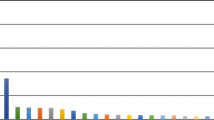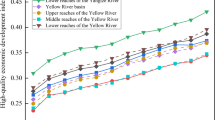Abstract
Due to its great strategic significance in integrating regional coordinated development and enhancing the rise of Central China, urban agglomeration in the middle reaches of Changjiang (Yangtze) River has attracted much attention from both theoretical and practical aspects. Such research into the area’s economic network structure is beneficial for the formation of an urban- and regional-development strategy. This paper constructs an economic tie model based on a modified gravitation model. Subsequently, referring to social network analysis, the paper empirically studies the network density, network centrality, subgroups and structural holes of the middle reaches of Changjiang River’s urban agglomeration economic network. The findings are fourfold: (1) an economic network of urban agglomeration in the middle reaches of Changjiang River has been formed, and economic ties between the cities in this network are comparatively dense; (2) the urban agglomeration in the middle reaches of Changjiang River can be divided into four significant subgroups, with each subgroup having its own obvious economic communications, while there is less economic-behavioral heterogeneity among subgroups — this is especially true for the two subgroups that exist in the Poyang Lake Ecological Economic Zone; (3) an economy pattern driven by the central cities of Wuhan, Changsha and Nanchang has emerged in the urban agglomeration of the middle reaches of Changjiang River, while these three capital cities have exerted great radiation abilities to their surrounding cities, the latter are less able to absorb resources from the former; (4) the Wuhan Metropolitan Areas and the Poyang Lake Ecological Economic Zone have more structural holes than the Ring of Changsha, Zhuzhou and the Xiangtan City Clusters, meaning that cities at the periphery of these two areas are easily constrained by central cities. The Ring of Changsha, Zhuzhou and the Xiangtan City Clusters have fewer structural holes; thus, the cities in this area will not face as many constraints as those in the other two areas.
Similar content being viewed by others
References
Batten D F, 1995. Network cities: Creative urban agglomerations for the 21st century. Urban Studies, 32(2): 313–327.
Bunnel T, Barter P A, Morshidi S, 2002. Kuala Lumpur metropolitan area: A globalizing city-region. Cities, 19(5): 357–370.
Burt R S, 1992. Structure Holes: The Social Structure of Competition. Boston, MA: Harvard University Press.
Burt R S, 2000. The network structure of social capital. Research in Organizational Behavior, 22: 345–423.
Freeman L C, 1979. Centrality in social networks: Conceptual clarification. Social Networks, 1(3): 215–239.
Garreau J, 1991. Edge City: Life on the New Frontier. New York, NY: Doubleday.
Glaeser E L, 1999. Learning in cities. Journal of Urban Economics, 46(2): 254–277.
Glückler J, 2007. Economic geography and the evolution of networks. Journal of Economic Geography, 7(5): 619–634.
Gu C, 2011. Study on urban agglomeration: Progress and prospects. Geographical Research, 30(5): 771–784. (in Chinese)
Gu C, Pang H, 2008. Study on spatial relations of Chinese urban system: Gravity Model approach. Geographical Research, 27(1): 1–11. (in Chinese)
Haythornthwaite C, 1996. Social network analysis: An approach and technique for the study of information exchange. Library & Information Science Research, 18(4): 323–342.
Henderson V, Mitra A, 1996. The new urban landscape: Developers and edge cities. Regional Science and Urban Economics, 26(6): 613–643.
Kim T J, 1999. Metadata for geo-spatial data sharing: A comparative analysis. The Annals of Regional Science, 33(2): 171–181.
Li C, 1995. Inter-regional connectivity: As a recent frontier of regional geography. Acta Geographica Sinica, 50(6): 491–496. (in Chinese)
Liu C, 2004. Empirical analysis on the spatial structure of logistics economic linkages in China mainland. Economic Geography, 24(6): 826–829, 868. (in Chinese)
Liu J, 2004. An Introduction to Social Network Analysis. Beijing: Social Science Academic Press. (in Chinese)
Liu J, 2009. Lecture on Whole Network Approach: A Practical Guide to Ucinet. Shanghai: Truth & Wisdom Press. (in Chinese)
Losch A, 1940. The Economics of Location. New Haven, CT: Yale University Press.
Luo J, 2010. Social Network Analysis. Beijing: Social Science Academic Press. (in Chinese)
Lv K, Wang J, 2011. Study on networked development of the Yangtze River Delta cities. China Soft Science, (8): 130–140. (in Chinese)
Matsumoto H., 2004. International urban systems and air passenger and cargo flows: Some calculations. Journal of Air Transport Management, 10(4): 241–249.
Meng D, Lu Y, 2009. Strength and direction of regional economic linkage in Jiangsu Province based on Gravity Model. Progress in Geography, 28(5): 697–703. (in Chinese)
Meng X, Jia S, 2000. Statistical analysis of China’s large city development and regional dependence. Chinese Journal of Population Science, (5): 40–44. (in Chinese)
Niu H, Meng Q, Hu Q et al., 1998. Economic interaction analysis between regions of Gansu Province and their surrounding areas. Economic Geography, 18(3): 51–55. (in Chinese)
Perroux F, 1950. Economic space: Theory and applications. The Quarterly Journal of Economics, 64(1): 89–104.
Pred A, 1977. City Systems in Advanced Societies. London: Hutchinson.
Reilly W J, 1931. The Law of Retail Gravitation. Austin, TX: University of Texas.
Seidman S B, Foster B L, 1978. A graph-theoretic generalization of the clique concept. Journal of Mathematical Sociology, 6(1): 139–154.
Storper M, 1997. The Regional World: Territorial Development in a Global Economy. New York, NY: Guilford Press.
Taaffe E J, 1962. The urban hierarchy: An air passenger definition. Economic Geography, 38(1): 1–14.
Wang D, Zhuang R, 1996. The preliminary probe into the quantitative analysis of regional economic links: A case study on economic links between Su-Xi-Chang and Shanghai. Scientia Geographica Sinica, 16(1): 51–57. (in Chinese)
Xiong J P, Liu C L, Yuan J, 2006. Progress in foreign research on economic linkages of city agglomeration. World Regional Studies, 15(1): 63–70. (in Chinese)
Yang W, 1989. Principle of Location Theory. Lanzhou: Gansu People’s Publishing House. (in Chinese)
Zhang M, Gu C, Chen L et al., 2006. Spatial structure construction of global city-region in the Yangtze River Delta. Resources and Environment in the Yangtze Basin, 15(6): 787–792. (in Chinese)
Zhou Y, Zhang L, Wu Y, 2001. Study of China’s urban centrality hierarchy. Areal Research and Development, 20(4): 1–5. (in Chinese)
Zhu D, Wu, X, Zheng J, 2008. Application review of gravity model in economic researches. Journal of Yunnan Finance and Trade Institute, (5): 19–24. (in Chinese)
Zhu Y, 2003. The study of air transportation links among urban compact district of Huninghang. Human Geography, 18(5): 22–25. (in Chinese)
Zipf G K, 1942. The unity of nature, least-action, and natural social science. Sociometry, 5(1): 48–62.
Author information
Authors and Affiliations
Corresponding author
Additional information
Foundation: National Natural Science Foundation of China, No.41371182; Key Project of Hunan Social Science Foundation, No.12ZDB01; Entrusting Project of Hunan Social Science Foundation Base, No.12JD12
Author: Sun Qian (1977–), PhD Candidate and Associate Professor, specialized in spatial economics and real estate economics.
Rights and permissions
About this article
Cite this article
Sun, Q., Tang, F. & Tang, Y. An economic tie network-structure analysis of urban agglomeration in the middle reaches of Changjiang River based on SNA. J. Geogr. Sci. 25, 739–755 (2015). https://doi.org/10.1007/s11442-015-1199-2
Received:
Accepted:
Published:
Issue Date:
DOI: https://doi.org/10.1007/s11442-015-1199-2




